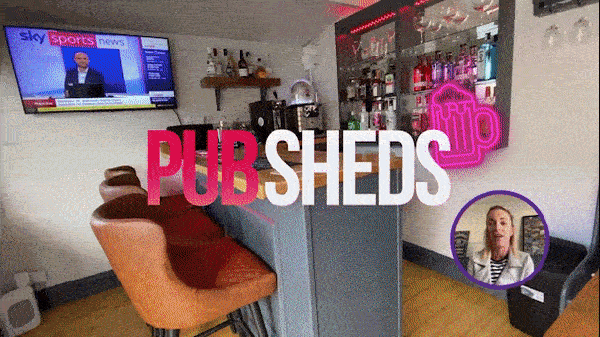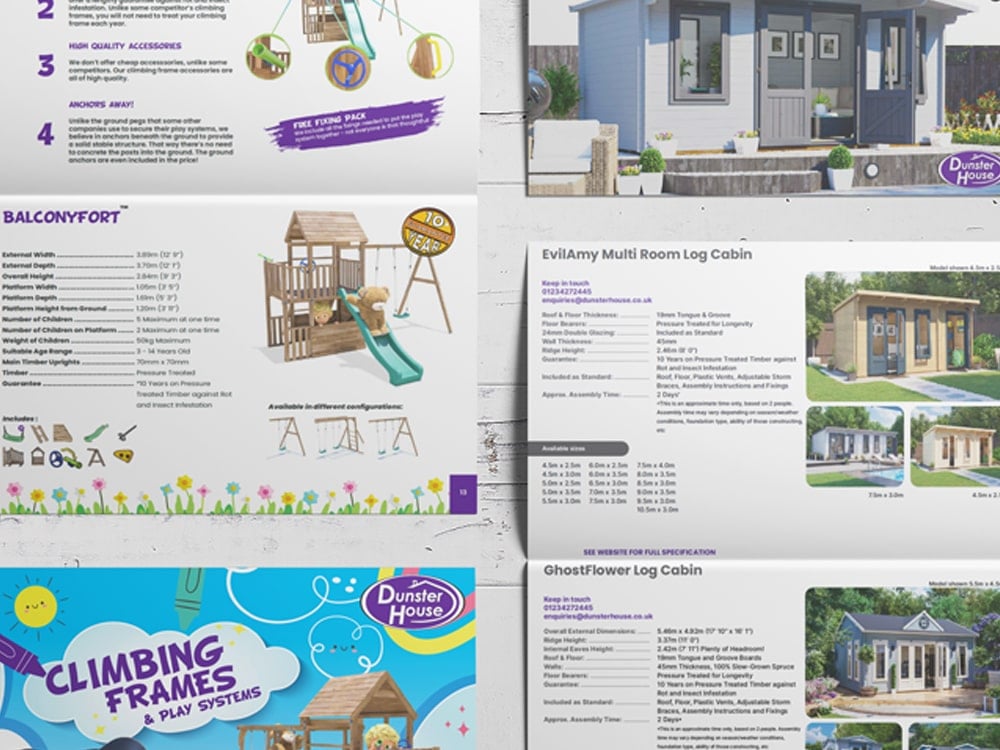We have put together a handy collection of climbing frame FAQs. Here you will find some of the commonly asked questions and answers regarding building and maintaining your Dunster House climbing frames. If you cannot find the answers you are looking for, please don’t hesitate to contact us.
More information can also be found in your installation manual, located with your climbing frame packs. If you have not yet received your delivery, you can access your manuals via the Customer Log-In Area on our website.
We know that our climbing frames are of a high enough quality that they will be sure to last. We have confidence in their safety and longevity. This is why we know that we can provide a 10-year guarantee on our pressure treated climbing frames. However, as with any outdoor product, they do require a certain level of maintenance to keep it looking its best throughout the seasons. With correct construction, including pre-drilling of all necessary parts, proper maintenance and care, your climbing frame will be the perfect investment for your garden.
Why buy a Dunster House Climbing Frame?
You should buy a Dunster House Climbing Frame because of our rigorous safety testing, the longevity of our products (with guarantees), included accessories and our commitment to the Timber Development sustainability policy, just to name a few. To hear more about the things that make our climbing frame amazing watch our video on How to Choose the Right Climbing Frame.
What base do I need for my climbing frame?
Climbing frames are a very versatile piece of garden equipment. They can be placed on most surfaces, providing that it is flat and level and can hold ground anchors, or allow for them to be cemented (if and where possible) beneath the surface. As well as grass, some commonly used surfaces for a climbing frame include play bark, woodchip, rubber or sand.
Find out more in our useful article on what to put under your climbing frame.
Is my Climbing Frame pre-drilled?
All the bolt holes on our climbing frames are carefully engineered to ensure that you can safely and securely fit your bolts and tighten them to prevent any movement between the timbers. We do not pre-drill screw holes in the climbing frame parts. It’s very important to spend some time doing this to properly prepare your timber parts and prevent any splitting of the wood. When a screw goes into wood it needs to displace the space it takes up. This causes the wood fibres to get pushed outwards, and the pressure can create cracks in the wood. By drilling a smaller hole first, you eliminate some of the wood before the larger screw goes in. Taking the time to do this can help to make sure that your climbing frame will last in your garden for many years.
How can I screw in my Monkey Bar/Ladder rungs without the screws clashing?
One of the trickier steps in the instructions comes when fitting the rungs onto the monkey bar or ladder. The 4x50mm countersunk screws must be driven into both sides of the rung, as shown in the diagram on the instructions. In order to prevent them from clashing, it is advised to drill in the screws whilst slightly angling them away from one another. Find an online version of your instructions in the Customer Log-In Area.
How do I adjust the rope on my Baby Seat swing?
If you have opted to have a Baby Swing as one of the options for the swings on your climbing frame, you may have to adjust the ropes to fit the swing. This is a good idea if you feel like the swing is tipping forward at all. You should make sure this is done properly and safely. We have a useful video to help you with this. You can watch it here. You may find that the ropes come unthreaded from the babyseat. See this article for advice on how to re-attach the babyseat ropes.
How do I fit the ground anchors?
Unlike some competitors, we supply metal ground anchors as standard. You can find more detailed instructions and diagrams towards the end of your instruction manual. The holes required for the ground anchors should be around 520mm long and 100mm wide for the disc. Once you have dug a hole for each ground anchor, place the disc end into the ground. Pre-drill the holes into the legs as per the instructions, and use the bolts provided to attach the looped end of the anchor to the climbing frame as low down as possible. When the anchors are firmly attached to the climbing frame, fill in the holes with compacted soil. If you find that the soil does not hold the anchors in place sufficiently when the tower is in use, you will need to use concrete to secure them.
What seasonal checks should I do of my climbing frame?
We pride ourselves in knowing that we manufacture products that will last, and that will require minimal maintenance. However, seasonal checks and maintenance are important to ensure that your climbing frame continues to remain safe and in good condition to prolong its life. Inspecting the timber, base and fixings are all important.
How can I make sure the fixings and accessories on my climbing frame remain safe?
- Check all nuts and bolts for tightness and tighten when required. If they have sheared, replace them.
- Check all screws to ensure they have not sheared and replace where necessary.
- Oil all mechanical moving parts, e.g. Swing hooks.
- Remove swinging ancillaries when not in use to avoid damage by abnormal weather conditions.
- Check swing seats, ropes and other means of attachments for evidence of deterioration and replace if required.
- Check all anchors are secure and tighten or replace if required. If the ground anchors are pulling out of the soil, dig them in again and cover them with concrete.
How do I remove the green safety caps to tighten the bolts?
The safety caps are designed so that they cannot be easily removed and will not fall off. For this reason, it is very difficult to remove them without breaking them. Prying them off gently is the best way to remove them without them breaking. But if you do find that they break in the process, just drop an email to [email protected] and we will be able to replace them quickly and easily.
WATCH THIS VIDEO: Fitting and Removing Green Safety Caps on Climbing Frames
What can I do if I notice my swing hooks squeaking when used?
Swing hooks need seasonal maintenance, by applying some WD40 or similar to lubricate the mechanism. This will stop any squeaking.
Is my climbing frame under warranty?
Due to the fact that our climbing frames are pressure treated, we offer a 10 year guarantee against rot and insect infestation. Find out more information on our Pressure Treatment Guarantee.
Certain parts, such as the slide and baby seat are covered by a 1-year manufacturer’s guarantee. But any other additional parts and optional extras will need to be purchased when replacements are required.
Is the climbing frame treated?
Our climbing frames are manufactured using pressure treated timber. This means that the timber has been treated using a method whereby the wood preservatives are forced deep into the timber in a machine at high pressure. This makes the timber much more effectively resistant to moisture absorption and insect infestation.
Do I need to treat my climbing frame?
Despite the climbing frame being pressure treated on manufacture, you might wish to maintain it on occasion to keep it from drying out. If it starts to looks pale or faded it is likely that it will need treating. A suitable treatment to use on pressure treated timber is either a clear water repellent, or similar preservative suitable for use on pre-treated timber.
What can I do about cracks or splits in the timber?
If you find that you have any cracks or splits in the timber parts of your climbing frame, don’t panic. Timber is a natural material and when it dries out, may crack or split. Treating the timber using a clear water repellent can help to prevent the timber from drying out enough to crack or split.
However, one thing to be wary of is that you do not over-tighten the bolts during assembly of your climbing frame. Doing so can put too much strain on the timber, which can lead to cracks or splits.
What is sap? What can I do about sap appearing on my climbing frame?
Another natural property of timber, is the appearance of sap leaking from the material. Thanks to the high quality of the spruce timber used on our products and the pressure treatment applied on manufacture, the timber is less likely to produce sap.
However, if you do find some sap on your climbing frame, you should not be concerned. You can either leave it to dry out and then cut it off with a sharp knife, or wipe it clean using white spirit.
How can I remove mould or mildew from my climbing frame?
If there is mould on the timber, it will need cleaning with a mild bleach solution or mould cleaner to kill the spores. You can remove mildew using a mild detergent and warm water.
How can I prevent my climbing frame from moving or swaying during use?
Please ensure that all holes are pre-drilled on installation and that all components are in the right place. As advised above, as well as in the installation manuals, ensure that you regularly check your fixings for tightness to secure and stabilise your climbing frame. If you still find that your climbing frame is moving, you can also check your ground anchors to be sure that they are firmly in place. Or ideally, cemented into the ground. If you are still concerned about movement in your climbing frame, get in touch via email to [email protected].
What is the best way to maintain my slide?
For detailed information on how to install and look after your plastic slide, see the detailed instructions at the end of your installation manual. The most important things to remember are that the slide should not be:
- over-strained at the joints, or on the surface- maximum weight 50kg
- installed on an uneven surface
- installed with any gap between the slide and the edge of the platform
- lifted from the bottom whilst it is still attached (for example, to mow the lawn)
Can I modify my climbing frame?
Our models are independently tested to ensure that they comply with EN71 safety regulations. These high standards that they meet only apply to our designs. If you modify the model in any way or add additional timbers, we cannot confirm that the climbing frame will remain as safe as we intend for it to be. We therefore would not advise changing the structure of your climbing frame at all. What you can do, however, is add extra variations to your climbing frame with additional choices of swings. You can interchange these extras with the swing seats that come as standard with your climbing frame, allowing you to use the existing metal swing hooks. You can find our range of swings and accessories on our optional extras page.
Require More Information or Inspiration?
;





